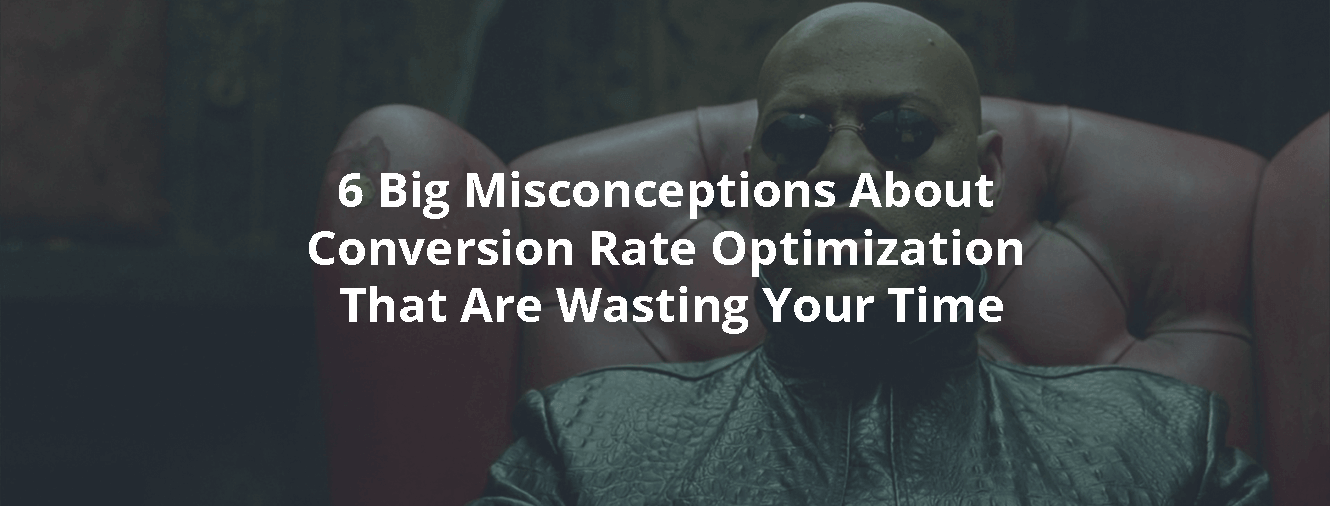
Conversion Rate Optimization (CRO) is a practice that never stops. There are always new things you can try optimizing to get even higher conversions. Previous articles around CRO included “The Basics Of Conversion Rate Optimization In Three Simple Steps”, “What is Conversion Rate Optimization and Why Should You Care?”, “How To Do Conversion Optimization With Almost No Traffic”, to name a few.
However, when talking to people in our area about the potentials of CRO, we still find that there are a lot of misconceptions about Conversion Rate Optimization.
Internet Marketing today is much more challenging than ever before. Technology and tools available to everyone are getting better every day, but this makes it also easier for your competitors to start using these tools, not to mention the ever growing improvement of the knowledge of the buyers of your product. All of these end up, with making it harder to achieve your business goals.
Conversion Rate Optimization turns out, is no longer something nice to have, but it’s turning into a must for every company. A lot of marketers are a bit skeptical at first, though, about a service that sometimes sounds too good to be true. If you’re the person responsible for lead generation in your company, or if you’re running an e-commerce website, implementing different experiments and learning from the results can dramatically improve the number of leads or orders you’re generating from your site.
When implementing these processes in your organisation, you will find that although a lot of the tips and tricks online look rather easy, it’s not such a simple process as expected. If you’ve been thinking of implementing different experiments on your website, but still have a few reservations, this article will help you set some misconceptions straight so you don’t waste your time.
#Misconception 1: Conversion Rate Optimization is about following “best practices”, and hoping for the best.
A common misconception about CRO is just blindly following marketing websites and thought leaders with huge lists of best practices. They may describe the processes they did in all in very detailed steps, telling you exactly what you have to do the get the same level of success as they did. The only problem with this? What works on one website, with a certain set of visitors in a certain niche, might work great for them, but marketing is not a one-size-fits-all game. What worked for them, might not work for you.
The truth: CRO is not about blindly implementing some lists of changes you’ve found on the internet if you don’t have the numbers yourself supporting these changes. Making changes to your landing pages or your website as part of a CRO strategy only works, if you’re able to analyse all your data and use the insights you get from them to guide the optimizations. Testing the little tweaks and changes you made on your website along the way to confirm that you’re improving your conversion.
#Misconception 2: Conversion Rate Optimization is about making small design tweaks
Hopefully by following our blog for a bit longer, you should understand that this is NOT what CRO is about. We’ve included this one in our list here, though because it seems to keep popping up. If you’ve got a low conversion on your website, you can be pretty sure it’s not just related to using the “wrong” color on your buttons and Call To Actions. By making small design tweaks to these items you might get a little higher conversion, but they will still not fix the underlying problem.
Header copy, buttons colors and small design elements, of course, play a role in CRO, but cosmetic changes are only a small part of what goes into a good optimization strategy. Maybe:
- there is a lack of trust or confidence in your site
- the process to convert your visitors seems too long and too much work for them
- your website is just slow
- your copy is confusing your visitors
- people arriving on your page can’t find what they are looking for
- etc., etc.
The truth: CRO is is about much more than just some cosmetic changes to your website. There are lots more things you can test. Things like product “quick views”, or one-page checkout processes can all help you get better conversions from your visitors. But until you test it, you will never know!
#Misconception 3: All visitors use the website in the same way
Another big mistake is thinking that all your visitors on your website are the same and they have the same behaviour on your site. Some marketers combine this by basing their assumptions about their customers only on their intuition and neglecting the statistics and all the information they can have available about the behaviour of their visitors.
By using tools like Google Analytics you can easily identify different characteristics of your visitors and segment your traffic. For segmenting your audience you can think of things like:
- their source (paid, organic, email, direct)
- localisation
- UTM parameters
- Cookies
- Device
- Purchase history
- etc., etc.
Once you’ve identified your primary traffic segments, you can start to personalise them according to the criteria you choose. Another great way to look into is the users’ flow in Google Analytics. If you click “User Flow” under “Demographics” and then from the drop down menu choose “Landing Page”, you can discover the biggest holes in your visitors’ flow.
The truth: There will always be exceptions to the rule, of course, and some visitors might behave in the same way as you. But must visitors will have their own flow through your website.
#Misconception 4: Surveys are not needed, I know everything about my users
Although you might have gotten years of experience in your pocket, and you’ve worked for years at the same company. Consumers change, businesses change. Just because you think you know well, doesn’t mean you should base your test and your strategy around the gut feeling you have.
The people who tell you that optimization is all about guesswork and gut feelings are probably the people who operate in the belief of this misconception. While gut feeling and hunches can be necessary steps in the formation of hypotheses, you’ve got no way of knowing whether these hypotheses are correct unless you can test them unless you can survey your visitors to find out more about them, etc.
The truth: CRO uses a data-driven approach to determining what it is that makes a visitor tick, what it is that is needed for them to convert. Instead of guessing these things, CRO utilises user feedback tools to ask current and potential customers directly. Although analytics is a vital piece to the puzzle, we can’t overstate the importance of user surveys and testing enough.
#Misconception 5: The shorter my copy, the better
Visitors who read your sales copy have questions, concerns or doubts. To convert, you must take away all those concerns they might be having in the most effectible way you can. The people who are genuinely interested in whatever it is you’re offering them are more than likely to want to have more information.
The biggest problem most of the times is not the length of the copy, but the fact that you write boring, poor copy that fail to connect with your audience and helps them to convert. Try making your copy as attractive, as clear and engaging as you can, without boring your reader. Make your pages as distraction free and easy to navigate as possible.
The truth: Is it worth it to eliminate useless pieces of copy to make it shorter and to the point? Of course, but don’t forget you’re trying to take away someone doubt and concerns they have about you. So don’t go for brevity just for the sake of brevity, aim to persuade your visitors instead.
#Misconception 6: Conversion Rate Optimization will solve all your problems
Some people and services will tell you that CRO will solve all your problems. They say that by just implanting X or Y you will have significant returns, which almost makes it seems that CRO will solve all your website and conversion problems. In the end, CRO is only part of the solution, though.
The truth: CRO might give you a robust, data-driven approach to better converting the visitors on your site, but with traffic you still can’t generate new leads. By offering an excellent product, by providing the best customer experience your customers might have, and by truly helping them solve their problems, you might be able to get more traffic to your website. CRO is one part of the entire journey of growing your business. However there are other important parts as well like, Search Engine Optimization, advertising, content marketing, social media, etc. to help drive that traffic to your site so you can start converting.
CRO can make a significant difference in your conversion rates, but only if you’re willing to take a structured and systemic approach that relies on qualified data points. If you think you might encounter another misconception and are not sure, keep one thing in mind. Anything that promises quick wins, without taking into consideration everything that makes you unique as an organisation is probably too good to be true.
Real optimization is not a one trick thing, real optimization requires hard work and figuring out what’s right for your site and your customers.

